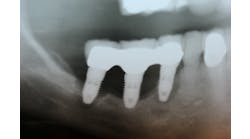Advanced salivary diagnostics' impact on the reduction of oral cancer mortality rates
According to the Oral Cancer Foundation and the National Cancer Institute, about 43,000 people in the United States will be newly diagnosed with oral cancer in 2014. This includes those cancers that occur in the mouth itself, in the very back of the mouth known as the oropharynx, and on the exterior lip of the mouth.
Since the soft tissue of the oral cavity is where periodontists, dentists, and hygienists focus much of their time and attention, it makes perfect sense for these dental professionals use every advantage they can to detect oral cancer early and, in turn, be a contributing factor in the potential reduction of oral cancer mortality rates.
Testing saliva for markers indicative of malignant transformation can be a noninvasive test helpful in diagnosing oral pathology. One example, the PeriRx salivary biomarker test for oral cancer, can serve as an invaluable addition to the dental clinician’s armamentarium for discovering oral disease.
The test is based on a strong scientific foundation of NIH-funded research, with initial discovery and prevalidation work by Dr. David Wong of the University of California at Los Angeles. Please refer to the article titled “Prevalidation of Salivary Biomarkers for Oral Cancer Detection.”
The PeriRx salivary diagnostic test for oral squamous cell carcinoma (OSCC) also has the distinction of being the first of its kind of assay in the world to aid in the identification and early detection of oral lesions and abnormalities at the highest risk for cancer. It achieves this by analyzing the patient’s saliva specimen to detect the presence of molecular RNA biomarkers that are specific to OSCC.
The test is administered chairside by having the patient rinse for 30 seconds followed by spitting into a funnel-equipped collection tube. The funnel is removed, the tube is capped, and the sample is then sent to a state-of-the art lab using provided shipping materials.
If within two days the lab report comes back positive, the patient should be consider having a biopsy for further histologic testing. If the test comes back negative, but there are still visible lesions, the dentist can employ a watchful waiting approach and reevaluate the patient in a few months to see if there have been any changes.
It must be noted that this test improves the accuracy of a visual oral cancer exam — whereas the clinician may visually identify an area of concern, this salivary test for OSCC will help quantify whether or not that concern is warranted.
The easy-to-use, noninvasive qualities of this test makes it easy to incorporate it into the workflow of any practice. The availability of this test to aid in the decision on management of oral lesions should increase the frequency of through oral cancer exams by all dental professionals — particularly on patients with certain risk profiles such as tobacco use, alcohol consumption, and multiple sex partners.
RELATED READING |Human papillomavirus and oral cancer
According to a new study conducted by the ADA Health Policy Resources Center (HPRC), screenings by dentists for the most common chronic medical diseases could save the American health-care system as much as $102.6 million annually, while providing healthier patient outcomes. Salivary diagnostic testing will be the means to this end.
ADDITIONAL READING |Head, neck, and oral cancer: A general reference for treatment








